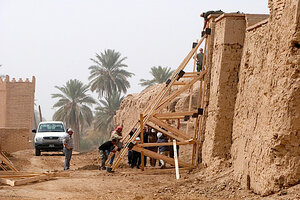A race to shore up the ancient walls of Babylon
After two failed bids, archaeologists seek to establish Babylon as a UNESCO World Heritage Site despite damage from Saddam Hussein and US troops. Those are just its latest encounters with conquerors, they argue.

World Monument fund workers erect scaffolding to shore up leaning wall of Babylon, Iraq, in February.
Jane Arraf
Babylon, Iraq
The sound of hammers echoes from ancient brick as Iraqi workers battling damage done by wind, water, and modern history race to shore up the crumbling walls of Babylon.
“If we don’t do something, in the next 10 years it will disappear completely,” says Thierry Grandin, a consultant to the World Monuments Fund overseeing workmen erecting wooden scaffolding to stabilize the 2,600-year-old north wall.
The capitol of the Babylonian empire, one of the wonders of the ancient world, has fallen on hard times.
Only a fraction of the 4,000-year-old site has been excavated; but the ruins above ground have been eroded by wind and salt water, and damaged both by sweeping reconstruction ordered by former President Saddam Hussein in the 1980s and the more recent US military occupation.
The Iraqi leader's project to rebuild the walls, literally in his own name, and create an imagined version of the ancient city has done major damage to the remains of the city. It also hampered the ruins' prospect for preservation. Despite Babylon's historical and religious significance, UNESCO has twice turned down Iraq’s bid to list the ancient city as a World Heritage Site.
“The main reason for the rejection was because of the interventions during the Saddam Hussein era,” says Jeffrey Allen, a World Monuments Fund consultant who has headed the conservation project since 2009. “There were large-scale interventions at Babylon that changed the dynamics and the appearance of the site. Those have compromised the integrity of the original remains.”
Crumbling bricks
Within the boundaries of the ancient city, on a hill above the excavated ruins, Mr. Hussein built a modern palace overlooking the ancient one. Bricks inscribed "in the era of Saddam Hussein" echoed those marking the reign of the biblical King Nebuchadnezzer. Empty spaces in the walls mark where some of the bricks were pried out while US soldiers controlled the area, say Iraqi antiquities officials.
The fragile walls of the old city are now sandwiched between heavier modern bricks pressing down on the original mud brick and a rising water table that has sent salt water seeping into the foundations of the ancient walls. In the 1980s, concrete was poured directly against the original brick. The conservation project is mapping the damage with a three-dimensional scan – brick by brick - to see how to stabilize the site and change the drainage pattern.
“If you taste the water you’ll taste salt in it here in Babylon, and that attacks the brickwork and destroys the brick and turns it to powder,” says Mr. Allen, crumbling some of the salt-coated 2,000-year-old brick in his hands.
The international visitors that local authorities would like to attract are limited mostly to diplomats under armed guard and an occasional French tour group marveling that they are actually in Babylon. It’s a popular spot for Iraqi school groups. On a recent weekend, high school girls giggled as they took photos of each other. A tour guide chased away a group of young men with a tambourine who were climbing on the basalt lion that was a symbol of Ishtar – the goddess of love and war.
“Babylon is a city that belongs to the whole world. It’s a global heritage, not just Iraqi heritage … so we’re trying to open the door to tourism,” says Salah Hassan Bihaya, a provincial official in charge of promoting development. His challenges include an almost complete lack of infrastructure, Babylon’s postwar history as a closed military site, and – until recently – uncertain security that has frightened away all but the most determined visitors.
New UNESCO bid: Babylon and its conquerors
In constructing his own palace in the 1980s, Hussein built a helicopter landing pad and infrastructure that made Babylon an appealing site to US military leaders looking for a military base after the Iraqi leader was toppled. American forces stayed for six months before handing it over to Polish troops in charge of the sector.
A British Museum report details what it calls significant damage to the site during the military occupation – including leveling parts of the ancient city that had yet to be excavated.
Not far from the ancient walled city, a military guard post still stands amid coils of barbed wire and piles of sandbags. Dubbed "Warsaw gate," it’s now eerily deserted. Reeds have overgrown the road used by military vehicles, and rare birds on the migration path are now returning to the area.
Allen says the next proposal to UNESCO to list Babylon as a protected world heritage site will include the Saddam-era reconstruction and even the US military occupation.
He says that along with the overall conservation plan, the Iraqi State Board of Antiquities has asked for help in maintaining what’s left of the onetime US and Polish military presence. The new proposal will argue that Babylon should not be considered as the pristine remnants of an ancient city, but as something wider – a city that from the earliest days of civilization was adapted to the whims and desires of its conquerors.
“The narrative has expanded,” says Allen. "From Hamurabi and the Bronze Age period all the way through Saddam and the military occupation of the site. That’s what we’re trying to do – spread the word that this is an evolving cultural landscape, not an archaeological monument of a moment in time.”

